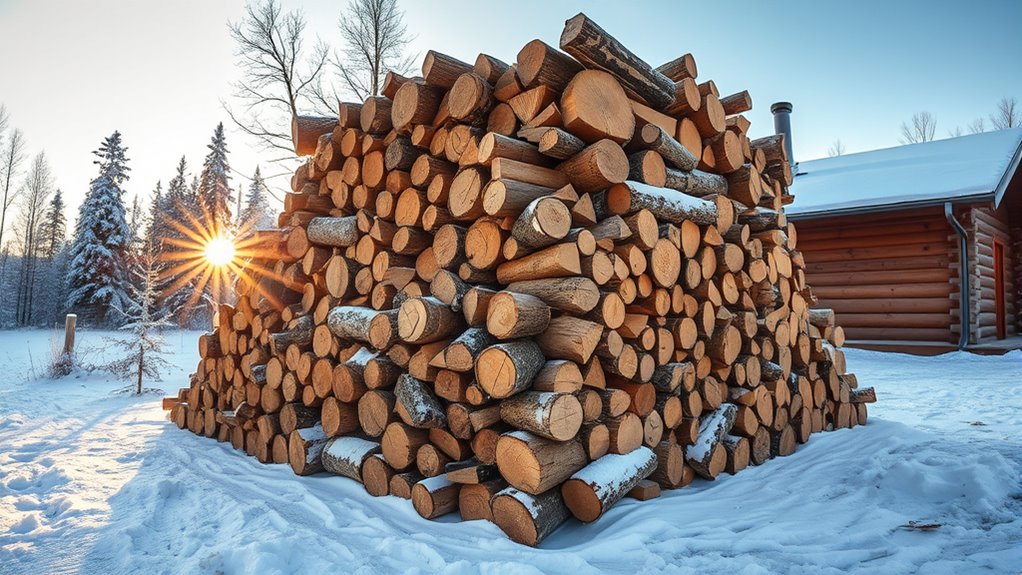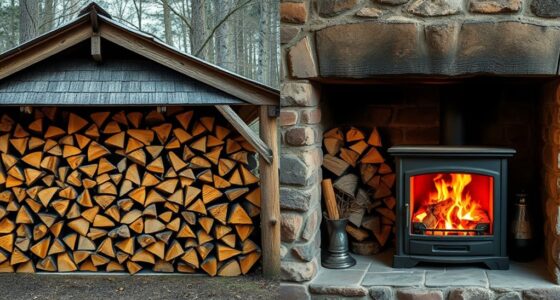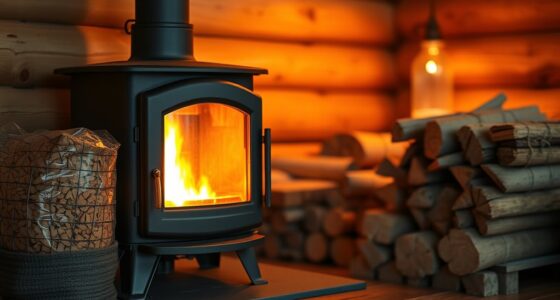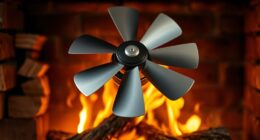To estimate how much firewood you need for winter, consider your home’s size, insulation, and typical weather conditions. On average, a well-insulated home may require 3-4 cords for the season, while poorly insulated ones need more. Track your past usage and adjust for colder months. Using properly seasoned wood and maintaining your stove also helps you burn less fuel. Keep going for more tips on accurately planning and managing your firewood supply.
Key Takeaways
- Estimate your home’s heating demand based on size, insulation, and local climate to determine total firewood needs.
- Calculate daily firewood consumption by considering appliance efficiency, firewood moisture, and desired indoor temperature.
- Season firewood for at least six months, storing properly to ensure optimal moisture content and burning efficiency.
- Track past usage patterns to refine future estimates and prevent shortages during cold months.
- Choose suitable firewood species with better burning qualities to maximize heat output and reduce overall fuel consumption.
Understanding Your Heating Needs
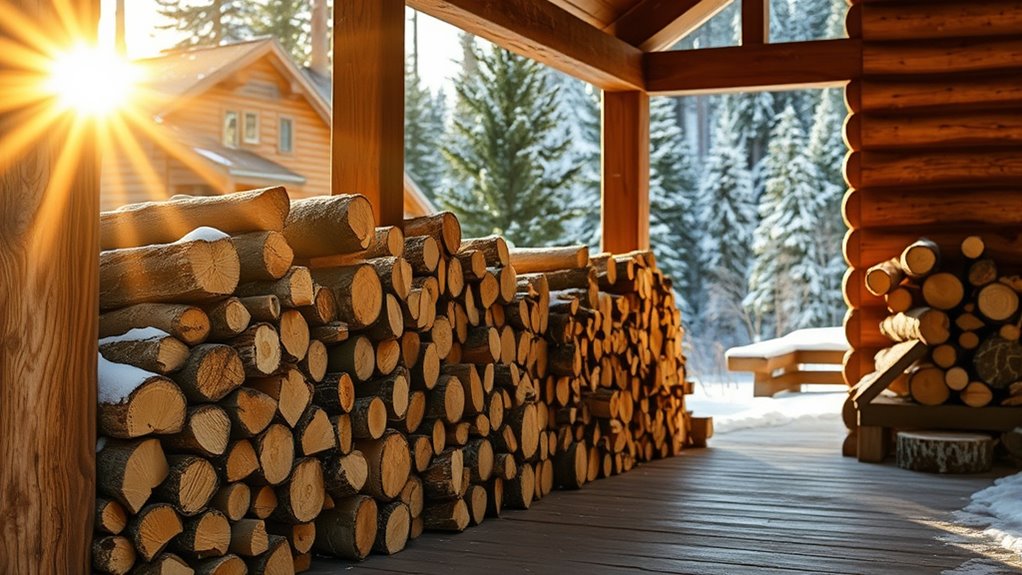
Before buying firewood, it’s essential to determine how much heat your home needs. The amount depends on your local seasonal temperature and the firewood’s moisture content. Dryer firewood burns more efficiently, producing more heat and less creosote buildup. Wet or unseasoned wood has high moisture, which makes it harder to ignite and causes smoke and excess creosote. During colder months, you’ll need more firewood to maintain a comfortable temperature, especially if your home isn’t well-insulated. Consider the typical winter temperature in your area, as lower temperatures demand more heat output. Properly seasoned firewood with low moisture content can significantly improve heating efficiency and reduce emissions. Knowing the moisture content of your firewood can help you select the best wood for optimal burn. Additionally, using appropriate firewood types can enhance combustion and heat production. Since the seasoning process reduces moisture content, properly seasoned wood is crucial for efficient burning and energy conservation. Furthermore, understanding how different heating appliances operate can help you optimize your firewood usage for maximum warmth. By understanding your home’s heating requirements and the moisture level of your firewood, you can better estimate how much you’ll need to stay warm throughout the season.
Calculating Your Fireplace or Stove Efficiency
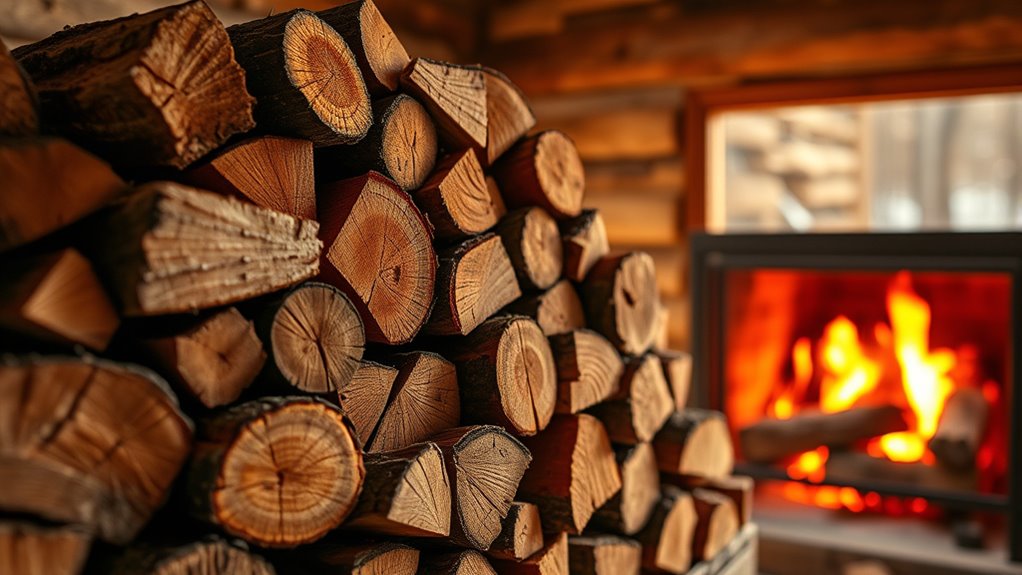
Knowing how much firewood to buy is only part of the equation; understanding your fireplace or stove’s efficiency helps guarantee you’re getting the most heat from your fuel. Regular fireplace maintenance ensures your appliance operates at peak performance, reducing heat loss and improving burn efficiency. One key factor is the wood’s moisture content—firewood should be seasoned to about 20% moisture or less. Wet or green wood burns inefficiently, producing more smoke and less heat, and can cause creosote buildup. To accurately calculate your stove’s efficiency, monitor how well it converts wood into usable heat, considering factors like airflow and sealing. Proper installation and venting are also critical for optimal performance. Additionally, using seasoned firewood maximizes heat output and reduces creosote buildup, leading to safer and more efficient burning. Ensuring your home has proper insulation helps retain heat and reduces the amount of firewood needed. Properly managing airflow around the fire can further improve combustion efficiency. Incorporating regular cleaning of chimneys and vents also helps maintain optimal efficiency and safety. By maintaining your fireplace and using properly seasoned wood, you maximize heat output and minimize fuel waste.
Estimating Firewood Quantity Based on Usage
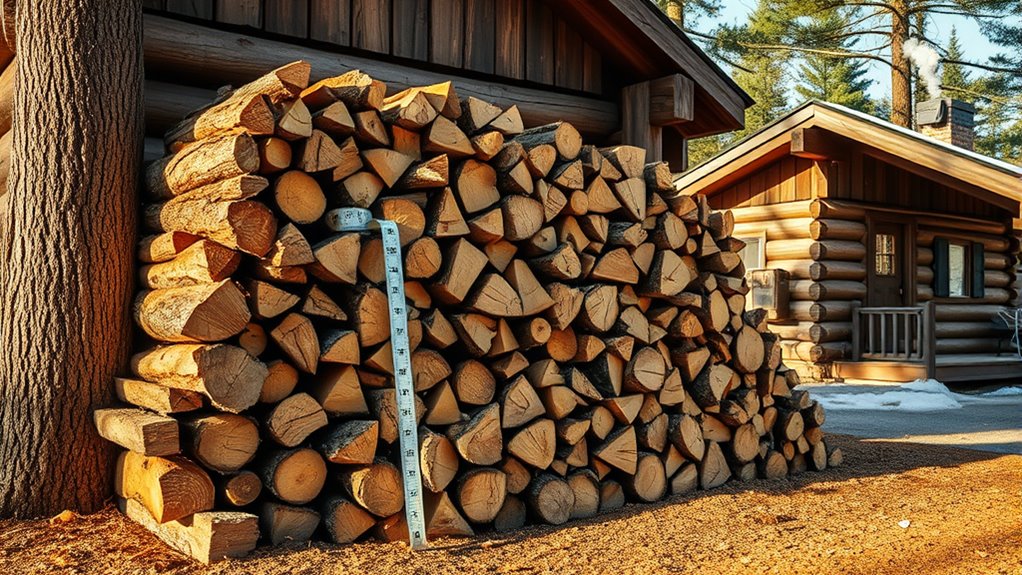
Estimating how much firewood you’ll need depends on your heating habits and the size of your space. To get an accurate estimate, consider your average daily usage and the efficiency of your stove or fireplace. Firewood moisture plays a vital role; wood with high moisture content burns less efficiently, requiring more fuel. Seasonal variations also impact your needs—cold, harsh winters demand more firewood than milder ones. Track your consumption over previous seasons to identify patterns. If you tend to burn longer or more intensely during colder months, adjust your estimates accordingly. By understanding your habits and the moisture content of your wood, you can better predict how much firewood you’ll need to stay warm all winter without running out. Additionally, monitoring your firewood’s moisture content ensures optimal burning efficiency, helping you conserve fuel and maintain consistent warmth throughout the season. Being aware of the tax implications of your firewood investments can help you plan your purchases more effectively and maximize your savings. Properly drying and seasoning your firewood can also improve combustion efficiency and reduce smoke generation, leading to cleaner and more efficient burning. For enhanced energy efficiency, consider using seasoned wood, which burns more completely and produces less creosote buildup.
Factors That Affect Firewood Consumption
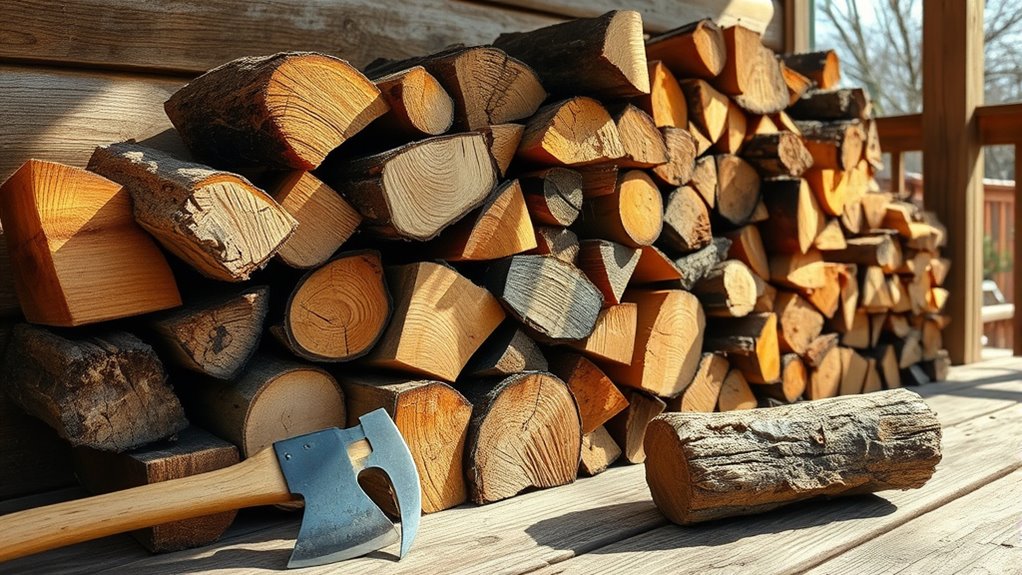
Several factors influence how much firewood you’ll burn during the winter. First, chimney maintenance plays a vital role; a clean chimney improves airflow and efficiency, reducing wood consumption. If your chimney is clogged or drafty, you’ll burn more firewood to maintain warmth. Second, firewood seasoning affects burn quality—well-seasoned wood burns hotter and produces less creosote, meaning you’ll need less wood overall. Fresh or unseasoned wood absorbs heat and smolders, increasing your fuel needs. Additionally, your home’s insulation, size, and desired indoor temperature also impact consumption. Your heating habits, such as how frequently you start fires and how long they burn, also matter; frequent, sustained fires use more wood than occasional fires. Properly stored firewood storage can also influence how efficiently your wood burns, making it an important aspect to consider. Moreover, understanding the firewood moisture content helps in selecting the best wood for optimal combustion and less waste. Using electric heated mattress pads can help reduce indoor temperature fluctuations, potentially decreasing heating fuel needs during very cold weather.
Tips for Properly Storing and Managing Your Firewood Supply
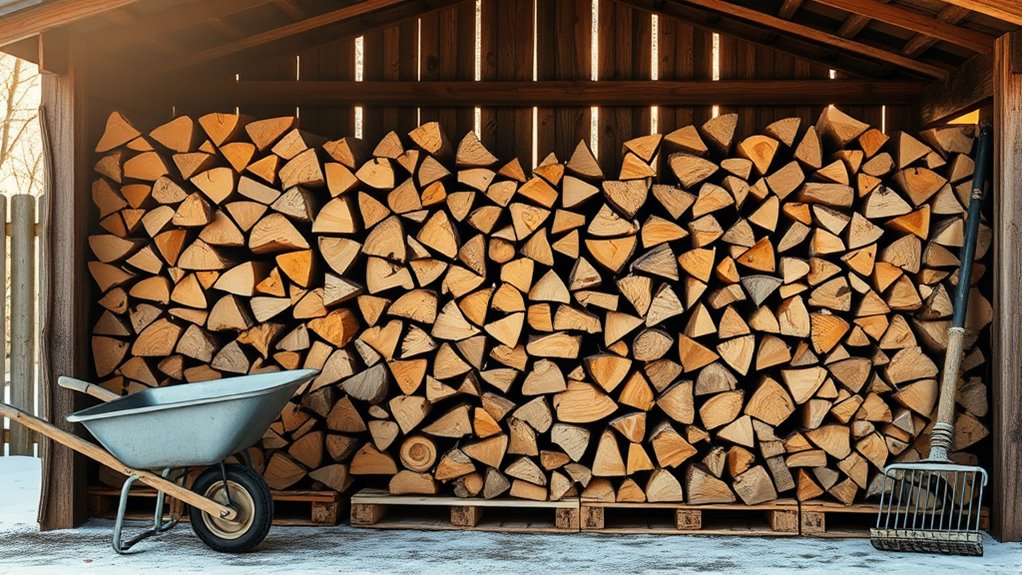
Properly storing and managing your firewood supply guarantees it stays dry, seasoned, and ready for use all winter long. To achieve this, assure your firewood is properly seasoned before stacking. Good firewood seasoning involves drying the wood for at least six months in a well-ventilated area. Use outdoor storage options like a firewood rack or covered shed to protect it from rain and snow while allowing airflow. Keep the stack off the ground to prevent moisture absorption and promote proper drying. Arrange the logs in a crisscross pattern for better ventilation. Regularly check your firewood for signs of mold or excessive moisture. Additionally, understanding seasoning and storage techniques can enhance the efficiency of your firewood. Incorporating proper ventilation methods can significantly improve drying times and reduce issues with mold or rot. Proper storage and management ensure your firewood remains efficient, reducing smoke and increasing heat output when you need it most. Ensuring the correct moisture levels in your firewood is essential for optimal combustion and safety. Maintaining consistent airflow and monitoring moisture levels are essential for optimal firewood quality, which can be improved further by choosing the right wood species suited for burning. Ensuring your firewood is stored correctly will lead to a more reliable fuel source throughout the winter months.
Frequently Asked Questions
How Do I Choose the Best Type of Firewood for Winter?
To choose the best firewood for winter, you should focus on firewood seasoning and wood moisture content. Opt for seasoned wood, which has low moisture, usually below 20%. This burns hotter, cleaner, and lasts longer. Avoid green or unseasoned wood to prevent excess smoke and creosote buildup. Look for hardwoods like oak or maple, as they’re dense and burn efficiently, providing consistent heat throughout the cold months.
What Are Signs That My Firewood Is Too Wet or Rotting?
You’ll notice signs that your firewood has too much moisture or is rotting if it smells sour or moldy. Wet firewood feels heavy, and when you knock on it, it produces a dull sound instead of a sharp one. Rotting firewood often has soft spots, discoloration, and may crumble easily. Always check for excessive moisture and avoid using rotting firewood, as it burns inefficiently and produces more smoke.
How Often Should I Replenish My Firewood Supply?
If you want to avoid running out of firewood during winter’s cold grip, you should replenish your firewood supply regularly. Check your firewood storage at least every few weeks, especially after heavy use or storms. Seasonal preparation means stacking fresh wood and rotating older pieces. Keep an eye on your supply, and don’t wait until it’s almost gone—staying ahead guarantees cozy, warm nights without surprises.
Can I Use Alternative Heating Sources Alongside Firewood?
Yes, you can use alternative heating sources alongside firewood to boost energy efficiency and reduce your reliance on wood alone. Options like space heaters, electric blankets, or pellet stoves work well, especially during milder days. Combining these methods helps you conserve firewood, lowers fuel costs, and maintains a cozy home. Just make sure your heating sources are safe, properly maintained, and suited to your home’s energy needs.
What Safety Precautions Should I Take When Burning Firewood Indoors?
When burning firewood indoors, prioritize fireplace safety by ensuring the chimney is clean and properly vented. Always use a screen to prevent sparks and keep flammable items away. Adequate indoor ventilation is vital; open a window slightly to prevent carbon monoxide buildup. Never leave the fire unattended, and install smoke and carbon monoxide detectors to protect your household. These precautions help you enjoy warmth safely and responsibly.
Conclusion
As winter’s chill approaches, think of your firewood as the heartbeat of your home’s warmth. Each piece symbolizes comfort, resilience, and preparation—fueling not just your stove but your sanctuary. By understanding your needs and managing your supply wisely, you guarantee the flame never dies, guarding your haven against the cold’s silent embrace. Remember, your firewood is more than fuel; it’s a quiet guardian, lighting your way through winter’s darkest nights.

